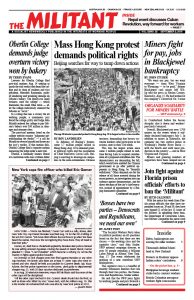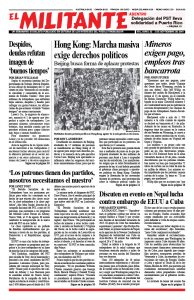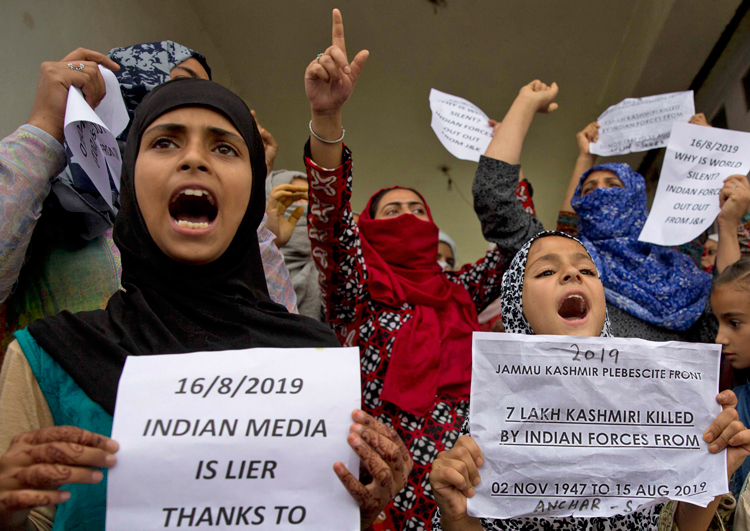After announcing it would ease curfew rules and some other restrictions it had imposed in Indian-occupied Kashmir, the Indian government reversed its stance Aug. 16, in response to continuing protests there. Working people have joined actions to oppose New Delhi’s decision to impose direct rule on the semi-autonomous area it has occupied for the past 70 years. By tightening its grip it aims to pave the way for greater exploitation of workers and farmers in Kashmir by India’s capitalist rulers.
Despite a communications blackout, curfew conditions in many areas, a large Indian troop presence and growing numbers of people detained, protests “were growing more intense,” Reuters reported Aug. 18.
In Srinagar, the largest city in Kashmir, cops and Indian troops clashed with local residents dozens of times over the Aug. 17-18 weekend. Dozens were injured but only a small number went to area hospitals for treatment, fearing they would be arrested.
The state government announced Aug. 16 that telephone landlines were restored in parts of the city, but internet and cellphones remain blocked. Indian authorities also ordered Kashmir government employees to return to work and that schools would reopen Aug. 19. But classrooms in Srinagar were deserted that day with parents keeping their children at home.
An unnamed government magistrate told Agence France-Presse that “at least 4,000 people were arrested and held under the Public Safety Act,” which “allows authorities to imprison someone up to two years without charge or trial.” Three former chief ministers of Kashmir are among those arrested.
Indian Prime Minister Narendra Modi says his moves are necessary to remove Kashmiri appointed officials he says are corrupt and an obstacle to the area’s economic development. In particular he aims to advance the interests of the capitalists and landowners in India against their rivals in Kashmir by ending rules that bar Indians from owning land there.
The conflict in Kashmir has its origin in the India Partition in 1947 by the departing British colonial power. In face of a rising, united working-class struggle against colonial rule, London moved to cede independence. It maneuvered with bourgeois and landlord forces to divide the colony into a majority-Muslim Pakistan and a majority-Hindu India. The goal was to divide working people and their struggles, thwart steps towards a unified nation-state, and help maintain the influence of the British capitalist rulers.
In the state of Kashmir, the local monarch initially declined to join either Pakistan or India. The new government in Pakistan invaded and its Indian counterpart retaliated. A United Nations-brokered cease-fire in 1948 placed two-thirds of Kashmir under Indian rule and the remainder under Pakistan. It also called for a referendum on self-determination, but this was never carried out.
In an effort to gain support for partition, New Delhi granted a degree of autonomy to India-administered Kashmir.
Military tensions remain high between the governments of India and Pakistan, both of which are nuclear powers and continue to lay claim to the whole territory. An Indian soldier was killed in cross-border firing Aug. 17. And the Pakistan military said three of its soldiers were killed on the border earlier that week.
‘End occupation of Kashmir’
Other actions worldwide have expressed solidarity with the Kashmiris’ fight. At a rally in Auckland, New Zealand, Aug. 10, protesters held signs saying, “End occupation” and “Uphold the constitution,” referring to the Indian government’s decision to revoke article 370 granting Kashmir semi-autonomous status.
“The Kashmir Valley is the world’s most militarized zone,” Mujaddad Afzal, a student from Kashmir, told the Militant at the rally. New Delhi stations some 750,000 troops amid a population of 14 million in the area.
“We face two nuclear-armed powers,” Haris Murtaza, another Kashmiri student, said, “and one that has a lingering presence — China.”
In London, thousands demonstrated in opposition to the Indian government measures outside the Indian High Commission office Aug. 15 — Indian Independence Day, chanting “freedom! — Azadi.” Attendees came from around the U.K., including 21 buses from Leicester in the East Midlands and six from Bolton near Manchester. Most participants were Kashmiri and Pakistani immigrants; others of Bangladeshi, Somali and Indian descent.
Five days earlier about 500 people attended a similar solidarity protest in Birmingham, U.K. Speakers included local councillors, community leaders and representatives of women’s groups.
“Britain was the colonial power and, through partition, sowed the seeds of the denial of the Kashmiris’ right to self-determination,” Communist League leader Jonathan Silberman said in his talk at the rally. Addressing calls by others that the U.K. government impose sanctions on India, he said, “It’s not ‘our’ government. It defends the interests of the ruling rich in both its domestic and foreign policy.”
Dag Tirsén in London and Janet Roth in Auckland, New Zealand, contributed to this article.


